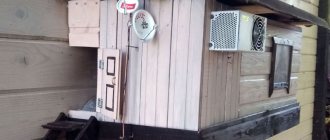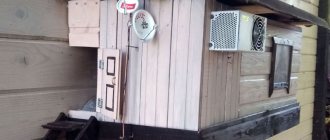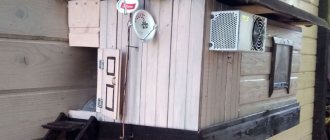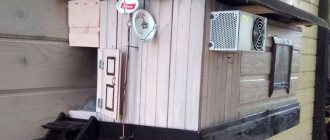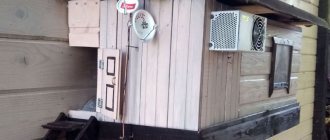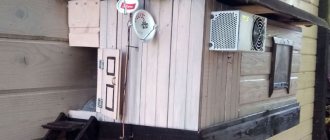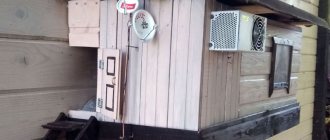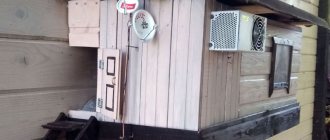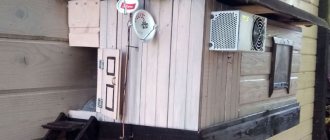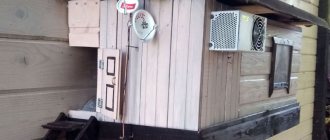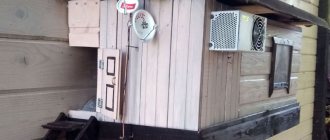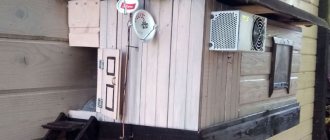Another homemade product for those who are bored at home
I needed a couple of antennas for digital, in places with “not the best reception”... I went shopping (this was before self-isolation - if it’s relatively budget-friendly, then it’s complete G. The more expensive one looks decent, but how it works is questionable.
- if it’s relatively budget-friendly, then it’s complete G. The more expensive one looks decent, but how it works is questionable.
I decided to make something homemade. It was somehow awkward to “twist” an antenna from a piece of cable (although rumor has it it works) - I wanted something simple, but more decent and advanced
In fact, the one I made is not radically more complicated, but somehow more “solid” or something. And the results of its testing were very encouraging, so I decided to sketch out a short description of what and how, in case someone else finds it useful 
... even if my street cats have a “normal” antenna on their house, what can you do without an antenna?!
The wire is not all finished yet, now we’ll assemble something!
In the places described, I previously used home-made broadband log-periodic antennas, probably since the “beginning of perestroika.” They worked well in analog and not only on UHF, but “for some reason, digital was too tough for them.” I didn’t really delve into the essence of the reasons, I removed them and began to think about what to replace them with. Here is one of them, waiting for a place in the trash
They worked well in analog and not only on UHF, but “for some reason, digital was too tough for them.” I didn’t really delve into the essence of the reasons, I removed them and began to think about what to replace them with. Here is one of them, waiting for a place in the trash
A little history
In the early 60s of the last century, our compatriot Kharchenko K.P. developed a simple flat zigzag antenna with good characteristics.
Copyright certificate No. 138277 for an invention called “Band directional antenna” was issued to Konstantin Pavlovich Kharchenko in 1961 (according to his application dated June 16, 1960). In the same year, materials were published in the magazine “Radio” for repetition by radio amateurs.
The antenna is not critical to materials and dimensions during manufacturing, has a simple good match with the reduction cable, and it successfully combines multiple elements of a common-mode antenna array with a single feed point.
How to make a powerful antenna for a TV?
It is clear that for areas with uncertain reception associated with significant distances or difficult terrain, an indoor antenna will not be the best option. But to receive the UHF range, which is required for on-air digital, there is a large selection of other types of devices - narrowly directed “wave channel” and log-periodic, frame and zigzag.
Moreover, for manufacturing it is not necessary to use copper or aluminum tubes or large-section cores from a power wire; even an option made from a cable used to connect a conventional antenna is quite available.
The main thing is to choose the best option for your conditions, maintain the recommended dimensions, and be extremely careful when assembling and connecting. In any case, in terms of cost, such options will be cheaper, especially if, according to reception conditions, you require an active antenna with an additional amplifier.
Theory and calculations
The described antenna, in theory, has a horizontal “figure-of-eight” radiation pattern and a relatively high gain, which can be further increased by using a reflector/reflector.
To obtain maximum gain on all channels, it is necessary to make an antenna approximately in the middle of the range between the multiplexes used.
Finding (for calculations) the frequencies of multiplexes used in your region is easy,
for example, a request like “dvb-t2 channel frequencies” + “Krasnodar”
I found something like this:
The middle, between “my” two multiplexes, is 700 MHz - we will calculate the antenna at this frequency.
As a basis for calculating the dimensions of the antenna, we take the drawing of its author
Calculate the wavelength: λ = 300 / f [m]
300/700 = 0.428m, approximately 43cm length of each side of the rhombus
λ/4
=43/4= 10.75
The total length of the material we need (11cm*8=88cm) is less than a meter. The distance between the reduction contacts, where we will solder the cable, is 10-12mm (the standard value for this antenna for frequencies below 900 MHz).
I will make a simple antenna, without a reflector, however, to further increase the gain of this antenna, it is quite possible to install it behind it
for example, from a metal mesh/grill, foil material or simply a metal plate. Its dimensions should be approximately 20 percent larger than the dimensions of the antenna and it should be located at a distance of ƛmax/7. For my case: wavelength (channel 39) 300/618, it turns out...49/7= that is, about 7cm
For those who are too lazy to do the calculations themselves
— you can use an online calculator, the results will differ only slightly from those I received. Here, for example, this one - here you immediately enter the frequencies of two multiplexes and get the dimensions of the antenna (without a reflector) Or another option, with a reflector - I really want to note that in the second option a slightly different calculation option is used, different from the author’s. An antenna with angles other than 90° is assumed and the reflector distance is calculated as λ/8
To make the antenna sheet, it is recommended to use aluminum or copper (copper is easily soldered) with a diameter of 3 mm and higher - the larger the diameter, the more broadband the antenna is. You can use tubes; the thickness of the walls is not important, since only the surface of the material is used (in fact, you can wrap any dielectric with foil to obtain the required material). However, in my opinion, the easiest way is to buy a meter of large-gauge copper wire at an electrical supply store.
Antenna assembly
Let's remove the insulation from a piece of wire one meter long.
I got a wire with a diameter of 4.5mm
The tools you will need are a vice and a hammer. Measure approximately 11cm each and bend at an angle of 90°
The end result is to get such a “geometric” figure 
We cut off the excess and solder the ends. It should look something like this...
Solder the cable as shown in the photo.
We lay the cable along one side of the square and secure it with clamps. This arrangement of the cable is necessary for its coordination (there are different opinions, not everyone agrees with this statement).
When using a reflector, the antenna sheet at the extreme points of the squares can also be secured using metal stands, for example, soldered onto the remains of the same copper wire - there are points with zero potential (highlighted in green). In other places, fastening is allowed only through a dielectric.
Flying...receiver!
It is no secret that the higher the antenna was placed, the better it caught the signal, so industrial receivers were installed on the tallest buildings, not only in the USSR, but throughout the world. But what if you make a flying antenna?
In 1926, the Soviet inventor L. Tolchinsky voiced just such an idea - the scientist proposed tying an antenna to a balloon, to fix which at one point it was proposed to use cables with a constant supply of air to the balloon through special tubes.
It is noteworthy that later the designers developed this idea, and the flying antenna turned into an entire radio station, which ultimately became the prototype for reconnaissance and research balloons, which were actively used in Soviet times.
Tests
And finally, a performance check and a rough
assessment of the quality of the resulting antenna.
In fact, everything is simple with the test - turn it on, it works! And to evaluate whether the game was “worth the candle,” let’s compare the parameters of the received signal from the manufactured antenna with the one I’m already using at the dacha, with a declared gain of 11dBi
And to evaluate whether the game was “worth the candle,” let’s compare the parameters of the received signal from the manufactured antenna with the one I’m already using at the dacha, with a declared gain of 11dBi
The antenna is installed in the attic of a country house, at a distance of approximately 16 km from the tower.
Signal level: factory stationary antenna on the left / homemade on the right
At first glance, the difference is only 1% (95 versus 94) - but this is not a completely correct comparison, since my external antenna is connected through a splitter, which further weakens the signal.
Took it for... mercury!
In Soviet times, there were many tales that were accepted unconditionally to be believed, despite obvious contradictions. One of them is associated with a “mercury antenna,” which supposedly made it possible to receive any radio signal with amazing sound clarity.
According to rumors, one radio amateur actually managed to assemble such a miracle of technology, but since the antenna not only caught all the signals, but also jammed the communications between dispatchers and aircraft pilots, he was found and arrested.
If you believe other tales, the mercury antenna was produced by the KGB for the purpose of listening to foreign conversations, and the mercury product for TV completely jammed all equipment in the nearest radius, so it was easy to detect it, which is why not a single craftsman had the courage to assemble one .
Whatever one may say, the antennas of that time performed their function. Of course, most of them are hopelessly outdated, inferior in all respects to their modern counterparts, but even now they can be found on the roofs of buildings, albeit in the form of non-working artifacts.
Assessing the performance of the antenna
Let's try to make a more correct comparison by connecting through the splitter input.
Well, in addition, for clarity, let’s add the number of participants List of antennas taking part in the comparison:
1. External antenna Funke BM 4551 external long-range,
declared gain, from some sources (bought at Yulmart), up to 16dB
2. There is an old UHF loop antenna, from TV Electronica 313d, I must say, despite its simplicity, it’s a very good antenna, that’s why it’s been preserved 
3. I went to the store and bought for comparison in the review one of the cheapest, such as a symmetrical vibrator (100% the most purchased by pensioners, due to the low price).
I will carry out all “measurements” at one point, located as close as possible to the external antenna - its location was experimentally selected based on the maximum signal, so we can say that the conditions are approximately the same
So, we have already seen the signal level from the external antenna at 95% (at the time of current measurements it showed 94%), we take it as a standard. All comparisons are made by connecting antennas to the input on the splitter, to which an external antenna is usually connected.
Loop antenna, from Electronics 82% on 39 multiplex and 66% on 60
Budget with “horns” - 62%/38% (on the verge of losing the broadcast)
- 62%/38% (on the verge of losing the broadcast)
Double square - 92% on both multiplexes, about a couple of percent less than the external one
Out of curiosity, I decided to check the work of the reflector, which is easy to make from any metal mesh, plate or even foil... It REALLY works noticeably! The level rose to 96%!, which is even higher than the stationary one, with a declared gain of 11dB.
The most interesting thing is the object that I used as a reflector! 
There was no foil in the house; the only thing available with a metal surface of the required size was... a laptop cover (I have a metal case). But the main thing is the result! It’s clear that I’m not going to “tie” the laptop to the antenna, and its amplification is enough for me without a reflector
Antennas for digital television DVB-T2
Digital terrestrial television of the DVB-T2 standard appeared in Russia relatively recently, but is already quite popular. For example, our region, which is St. Petersburg and the Leningrad region, is fully covered by digital TV broadcasting, and any summer resident can, without any problems, please himself with watching channels in good quality, and without any subscription fee.
Of course, based on the experience and statistics we have collected, it cannot be said that all receivers, regardless of the “filling,” process weak DVB-T2 over-the-air signals equally well.
However, we can say with confidence that the quality of the received digital signal depends entirely on the television antenna at your disposal. And also, strange as it may seem, both from the TV cable and from the quality of its cutting. Thus, if with television reception in the city everything is more or less clear and relatively simple, then in order to enjoy watching your favorite TV shows in the country, you should more carefully select an antenna that will be able to provide high-quality reception of the terrestrial DVB-T2 signal in this particular place. And the choice will largely depend on the location of the nearest broadcaster, the signal of which will be “caught” by the antenna.
Antennas for terrestrial digital television.
In general, on-air television broadcasting is carried out on meter (MV/VHF) and decimeter (UHF/UHF) waves. To receive channels in the DVB-T2 digital format, an antenna that is capable of operating in the UHF range is sufficient. Moreover, a digital antenna is no different from a regular one, and the inscriptions on the boxes are like: “DVB-T2 antenna”, “Digital television antenna”, “Antenna for digital television”, etc. - a common advertising ploy. Many people already have all-wave TV antennas at their dachas; they may well be suitable for receiving an on-air digital television signal.
Everyone knows very well that antennas can be indoor and outdoor, active (with an amplifier) and passive, purchased and homemade. Giving recommendations for making homemade antennas is not within my competence and the purpose of this article. Here we review the antennas that you can buy in our store.
Indoor antennas for receiving DVB-T2 signals.
Indoor antenna Delta K131A.02
Indoor UHF antennas are very compact and there is nothing strange in the fact that many people want to use just such antennas in their dachas.
- Firstly, it’s not noticeable; in winter they don’t “cut it down” like a Christmas tree before the New Year.
- Secondly, there is no need to climb onto the roof, install a mast, and in general, there is a minimum of effort required to secure such devices.
But the peculiarity of reception at the dacha is that the DVB-T2 translator can be low-power and at the same time located quite far away, and sometimes even the house is in a lowland. What kind of indoor antenna is this?
Reception on it is possible only in a zone of reliable reception, where the level of the on-air digital television signal will be quite high.
Indoor antenna GoDigital 6454A
Those who want to use an indoor antenna in their dacha, since hunting can sometimes be worse than captivity, can be given fairly universal advice - if you can see a translator from your dacha or a nearby dacha, even from the roof of a house, then you can try connecting it to a DVB-T2 receiver instead of an antenna, for example , a piece of wire or coaxial cable.
Select the “Manual settings” channel item in the set-top box menu and set the desired channel (this process is described in any of the receiver reviews on our website).
Then, walk around the room with this antenna wire, for example, bring it closer to the window, try to raise it higher to the ceiling, move all the “equipment” to the attic, etc. If you get at least some minimal, more or less clear, and even more desirable, stable readings on the “Power” and/or “Quality” scales, then you can try a directional active (with amplifier) indoor antenna. With a high degree of probability it will “work.”
If an active indoor UHF antenna is used next to a fairly powerful broadcaster, for example within a city, then it is better if there is the ability to adjust the gain. A too strong signal for a DVB-T2 set-top box is just as bad as a weak one.
REMO 5302 - active indoor antenna
The statement that in the city you can catch a digital TV signal even as small as a nail is completely wrong. Each specific location of this “receiving nail” will be unique in terms of reception conditions. Even the antenna has to be selected.
Indoor antennas undoubtedly have many advantages, but, nevertheless, most often it happens that with all the manipulations with them in the conditions of a summer cottage, no signs of clear reception of an on-air digital DVB-T2 signal can be achieved. In this case, you will not be able to do without an external antenna.
And for options when the distance to the nearest broadcaster is tens of kilometers, an external antenna is definitely required.
And the main question here will be: which one?
Most likely, you will not be the only owner of a DVB-T2 receiver in your gardening.
Take a closer look at the antennas in neighboring areas and where they are directed. If there is such an opportunity, then talk to the owners, find out how their digital set-top box with such an antenna works. This will certainly help you make your choice.
External antennas for receiving DVB-T2 signals.
As a rule, when choosing an outdoor antenna, the following questions arise:
- Which antenna is best for receiving a digital TV signal in the country?
- Which is better - passive or active?
- Where is the best place to install the antenna?
- Which cable to choose?
Antenna cable and components
Unfortunately, an exact answer that will be valid in all cases can only be given to the last question.
The cable must be of high quality. You should not skimp on it, as a bad cable will negate all the advantages of even the best antenna. The central core should be thick and soft, the screen should consist of foil and copper, preferably tinned, braid, and not just foil. By the way, the highest quality cables use double foil, i.e. foil-film-foil. The cable diameter must be at least 5 millimeters. The easiest way to find accessories for a 6 mm coaxial television cable. However, there is quite a lot of information on the Internet about which cable is better to use and how and how a high-quality branded cable differs from counterfeits.
Now let's try to find answers to other questions that arise when choosing an antenna for receiving terrestrial digital television in the country. I will not delve into the scientific jungle and give sophisticated technical characteristics such as the protective coefficient of the antenna or the directivity coefficient.
The buyer may only be interested in the gain value of an antenna, and even then only when comparing several types of antennas.
As for manufacturers, we generally give preference to antennas produced by Saratov Electromechanical. As well as well-proven products manufactured under the “GoDigital” .
Powerful active antenna GoDigital AV6520
Modern outdoor antennas are made of steel or aluminum. Their forms are different, but the most effective for receiving a DVB-T2 signal are time-tested log-periodic UHF antennas and “wave channel” antennas.
As for the gain, then, to put it simply and very primitively, the longer such an antenna is, the more transverse elements it has, the greater its gain, all other things being equal.
I repeat, such antennas are perhaps the best option for receiving digital TV in the country. And it is them, mainly, that you can see in our store and on this website.
Moreover, the numerical values of the reception range indicated in the parameters of some antennas, as a rule, are aimed at high-power transmitters. And in digital terrestrial television broadcasting, both medium and low power transmitters are used. The height of the antenna mast structures is also different. Data on our region is available on this website spb.rtrs.ru.
And all this, as well as the terrain and the height of your antenna, also matters. In addition, the range and quality of reception are affected by dozens of other factors, including even the time of year and day.
Passive outdoor antenna GODIGITAL AV 9290
In general, if the nearest broadcaster is 25 km - 30 km away, the terrain is flat and there are no 30-meter trees directly in front of the house, then the reception of the digital signal should be reliable, and, most likely, an outdoor antenna without an amplifier (passive) will be suitable .
Anything that does not meet the above conditions can be classified as a zone of uncertain reception. For example, the house may be located in a lowland, the forest may be quite close, etc. In this case, an antenna with an amplifier (active) will help out.
However, unfortunately, not everything is very good; there are always some pitfalls. Here too, when purchasing an active antenna, be prepared for the fact that after some time the amplifier will most likely fail and will have to be replaced. Basically, the input stage of the amplifier "crashes" due to static electricity. This can be either a discharge from induced atmospheric static, for example, after a thunderstorm, or one that accumulates, for example, in dry, frosty weather (snow or dust is rubbed by the wind over the antenna).
At first glance, it seems that the problem of the effect of static electricity on an antenna amplifier is solved quite simply - with the help of grounding, but not in the country. In the conditions of a garden plot, such a decision is very ambiguous. Regular lightning protection, you see, is not such a common phenomenon. But there are also lightning bolts. It is absolutely impossible to build serious protection against them at the dacha. Thus, by grounding an antenna located at a dominant height, you get something like a lightning rod, into which, no matter how you look at it, this lightning will definitely strike, with all the ensuing consequences from this event. Do you need it?
So it turns out that there is no point in making grounding for a country television antenna. And when a thunderstorm approaches, you should disconnect all electrical appliances from the network ( namely, pull out the power cable plug from the socket ) - nothing more radical has been invented . Moreover, for lightning, any antenna inserted into a TV or DVB-T2 receiver that is connected to an electrical outlet is grounded. This should not be forgotten either.
However, let's return to active antennas.
Power supply for antenna with separator
Let me start with the fact that not so long ago, the traditional voltage for powering amplifiers of active TV antennas was 12 Volts, and, accordingly, they were all equipped with a network adapter with a separator.
Many still believe that this is an antenna amplifier. This is absolutely not true. The amplifier is located inside the housing of the most active television antenna, because it is designed to compensate for losses in the reduction cable and the splitter for several televisions, and what you insert into the electrical outlet and antenna socket of the television is a regular power supply and separator.
With the advent of DVB-T2 set-top boxes, the amplifiers of active antennas designed to work with these devices also underwent modification; they are designed for a supply voltage of 5 Volts . Almost every modern digital DVB-T2 receiver is capable of providing power to such an antenna amplifier itself without any additional network adapters.
Go ahead.
Built-in antenna amplifier Remo 8104
It is precisely because the amplifier is located in the antenna itself that the process of replacing it can be difficult. After all, usually, for better signal reception, the antenna is located quite high, and the amplifier can also be soldered, and not just installed on screws. In any case, the entire antenna has to be removed and then reinstalled. A more convenient option, close in its characteristics to an active antenna, it seems to me, is a regular passive UHF antenna and an amplifier installed in the cable break, the so-called mortise one. By the way, they also come in 5 and 12 Volts. I absolutely deliberately did not use the term “mast amplifier”.
With this option, the amplifier can be placed in a more accessible place, for example, in the attic of a house, which will greatly facilitate its replacement if necessary. But here it should be taken into account that the length of the reduction cable between the antenna and the input of the built-in amplifier directly affects the quality of reception. Purely theoretically, it should be no more than 5-10 meters in order to minimize noise and losses in the cable itself, but practically, more is possible. But the length of the antenna cable from the amplifier output to the RF (antenna) jack of the DVB-T2 receiver with a gain of about 20 dB is no longer of fundamental importance, even if there is a splitter in the circuit for several devices.
Antenna installation.
An antenna for receiving an on-air digital television signal in a country house can be installed on the roof of the house, on the balcony, in the attic or on the wall. Some even mount it on a nearby tree, for example, when they don’t want to damage the gable of the house or drill into the siding. But, in any case, first you need to decide on the direction in which your country antenna should “look”. Naturally, it should be directed towards the nearest broadcaster. You can see where it is located on the RTRS.RF website. Once you have decided on the direction, you can begin the installation. For this, you may additionally need a mast or bracket, since improvised means do not always save.
Antenna mounting bracket
The brackets for attaching the antenna to the wall come in different lengths; the longer the bracket is extended, the greater the angle you can rotate the antenna if necessary. There are simply situations when there is not one, but two or even three translators “nearby”, and you don’t know exactly which of them will receive the signal better.
As for the height at which the antenna will be located, it must correspond to the surrounding conditions (mountain-lowland, terrain up to the translator, etc.). Here I would mostly advise you to pay attention to the installation height of the antennas that are already available in the area, i.e. on neighboring dacha plots.
I think that we are not talking about long-range reception, in its full sense, in the case of digital television, so it is unlikely that you will need to strive for some exorbitant height of the antenna mounting. By and large, you need to try everything, despite the fact that, naturally, the higher the better.
For advanced users, to determine the required antenna mounting height, I can recommend getting acquainted with the linktest service.
As an epilogue.
You can summarize everything written above about antennas for receiving terrestrial digital television in the country by compiling a list of recommendations:
- To receive over-the-air DVB-T2 television broadcasts, an antenna that operates in the UHF range is sufficient. If you already have an all-wave television antenna at your dacha, then you can use it; you are unlikely to need to purchase another additional one;
- When choosing a country antenna and determining its direction, the successful experience of your country neighbors will be very useful;
- An indoor antenna in a country house can only be used if the area is located in a zone of reliable reception within the line of sight of the translator, when the level of the DVB-T2 digital television signal indoors is sufficiently high;
- The best quality of terrestrial digital signal reception at the dacha and in a country house will be provided by an external all-wave or UHF antenna. Directional antennas of the “wave channel” type and log-periodic antennas have proven to be the most effective when receiving DVB-T2 signals. All other things being equal, it is better to choose an antenna with a higher gain and/or lower mass;
- An unambiguous answer to the question - which antenna is better, active (with a built-in amplifier) or passive? - does not exist. You just need to take into account that the amplifier serves only to compensate for losses in the cable and/or splitter for several TVs, and if the antenna design itself does not receive anything at all, then there will be nothing to amplify either. The main disadvantage of active antennas is that the built-in amplifier, in the absence of normal lightning protection and “proper” grounding, quite often “crashes”. Any cheap arresters in the absence, I emphasize, of a reliable and, most importantly, well-made grounding system are also unlikely to help;
- I believe that in the overwhelming majority of cases, when receiving digital TV in the countryside, it is advisable to start by trying to “get by” with a passive antenna, and if necessary, you can always purchase an amplifier additionally. The cost of an active antenna with a built-in amplifier and, as an alternative, a passive antenna + an additional built-in amplifier, are practically the same. The second option is more practical, because if necessary, the mortise amplifier can be easily replaced;
- You should not strive to buy the most expensive antenna; it is absolutely not a fact that it will be better. Don’t pay attention to the tempting bullshit labels on the antenna packaging and the mind-blowing gain of tiny “nanotech” devices. As a rule, behind beautiful pictures and a set of “smart” words, there is blatant “trash.” But you shouldn’t skimp on the antenna cable; it must be of high quality;
- And lastly, if the seller of the store where you choose an antenna, instead of specific questions and advice, throws in incomprehensible terminology, and for greater importance talks about noise, about paths, about losses, about characteristics and resembles a radio amateur’s reference book, then it’s better to go to another shop.
In the article, I tried to use words that everyone can understand and, as you may have noticed, in the process of presentation I write quite often - most likely, theoretically, etc. The reason for this is that, of course, there is a lot of truth in the theory, but, firstly, we need to “drive, not checkers,” and secondly, state with 100% certainty whether any individual antenna will cope with Receiving an terrestrial digital television signal at your dacha is only possible by checking it in practice. It is enough to simply cut the cable carelessly or incorrectly, and believe me, this often happens, in order to “kill” the reception with the most wonderful antenna, and there are so many such “ifs”. For our part, in our store we collect statistics on the performance of the equipment we sell (antennas and DVB-T2 receivers) in various areas of the Leningrad region.
Conclusion:
I can confidently recommend repeating it!
Simple, “cheap and tasty”... One of the simplest, indoor antenna mounts... with ordinary suction cups - if you’re lucky with the direction to the television center
The next antenna "recommended for repetition" is... log periodic
“Crazy hands” were with you. Good luck and good mood to everyone! ☕
Good luck and good mood to everyone! ☕
